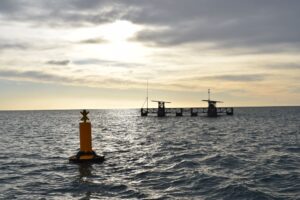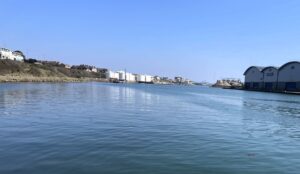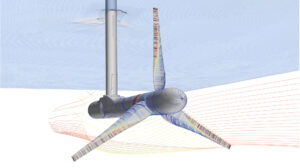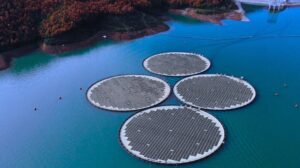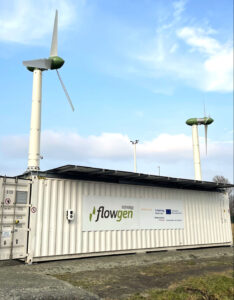Floating wind turbines: A promising start
 The bulk of the current plans for European offshore wind power are intended for construction in the relatively shallow North Sea. However, many European countries, including Portugal, do not border shallow seas. Their sea beds have steep descending slopes and much greater water depths not suited for current techniques. If a viable technique can be developed to deal with this problem, then many more countries could profit from offshore wind energy. The big winners of such a scenario would be remote places and islands like Hawaii, where energy is scarce and expensive. Floating wind turbines might just be the answer.
The bulk of the current plans for European offshore wind power are intended for construction in the relatively shallow North Sea. However, many European countries, including Portugal, do not border shallow seas. Their sea beds have steep descending slopes and much greater water depths not suited for current techniques. If a viable technique can be developed to deal with this problem, then many more countries could profit from offshore wind energy. The big winners of such a scenario would be remote places and islands like Hawaii, where energy is scarce and expensive. Floating wind turbines might just be the answer.
Floating wind turbines have a very short history and although the market is still in its infancy, today it seems that many people do believe that there is a future for floating turbines. So, what is the state of the market today, and what are the pros and cons of these large floating power plants?
In 2009, Norway had a world premiere when the state-owned energy company Statoil installed a full-sized floating wind turbine, called HyWind, off the coast of the southern Ameyfjord, where it had been assembled. The turbine was built in collaboration with Siemens and offshore technology company Technip and, with a power capacity of 2.3MW, it has been producing energy ever since. In 2011 it produced 10.1 GWh; much more than Statoil had expected, confirms Statoil’s spokesman Morten Eek. So far, 2012 has been somewhat less successful, but that was due to technical issues in the power grid, not to problems with the turbine itself.
For three years, the HyWind turbine was a lone pioneer. Until last spring, when the WindFloat was installed, that is. Portuguese utility company Energias de Portugal (EDP), one of the developers of the WindFloat, estimated that at water depths of between 40m and 200m, the Portuguese waters can potentially deliver more than 10GW of wind energy. While these depths are too deep for conventional offshore turbine foundations, investigating floating concepts could well pay off in the long run. The WindFloat and its 2MW Vestas turbine was moored to the seabed with four cables off the coast of the Northern Portuguese town of Porto. Interestingly, this turbine uses the same export cable that was laid there in 2008 for the Pelamis wave power prototype. If all goes well, the turbine will be accompanied by five more floating turbines within the next few years.
Spar
Three main floating turbine techniques can be distinguished. The first technique, which was used for HyWind in Norway, is called the spar. A spar is a long floating tube that is brought upright by adding ballast, of water and stones, to one end, resulting in a buoyant spar with most of it under water.
In the case of HyWind, the part underwater is 100m, with 65m above water, and the turbine blades add another 40m. This ratio is important to ensure the stability of the turbine. Just like a fisherman’s float, the deeper it sinks into the water the more stable it becomes. Several cables anchored to the seabed hold the spar in position.
Semi-submersible
The second technique is called the semi-submersible installation. This is a large floating platform with three or four interconnected columns that are placed as far as possible from each other. One or more turbines can then be mounted on top of this platform. The columns contain ballast and are partly submerged – hence the name. This technique obtains its stability from the large surface area and weight. The WindFloat in Portugal was built using this technique, which originated in the offshore oil & gas industry, as do many other floating technologies.

TLP
The last technique is called TLP (tension leg platform). This technique is a hybrid of the two techniques described above. Like the semi-submersible, it has several legs, but with the difference that the legs come together in the middle to support the turbine like a spar structure. However, instead of a large ballasted submerged structure providing the stability, the TLP is prevented from capsizing by stiff cables, or usually pipes, dragging it downwards, below its point of buoyancy.
TLPs are lightweight structures and inexpensive to build, but are complex to connect to the seabed and to stabilize. The Dutch firm Blue H technologies tested an 80kW TLP-based floating wind turbine off the coast of the Italian region Puglia as early as 2008.
Research
The Dutch research centre MARIN (Maritime Research Institute Netherlands) plays an important role in the world wide development of floating turbines. The institute has its background in testing floating structures for the offshore oil and gas industry, but in recent years MARIN has tested several floating wind turbine scale models. Recently it has also built a new high-quality wind generator specifically for testing the behaviour of floating turbines in bad weather. “Waves and currents are the most dominating factors for floating equipment in the oil and gas industry”, says researcher Erik-Jan de Ridder from MARIN, “But for floating wind turbines, wind appears to be the biggest factor. That is why we had to generate higher quality wind in the model basin than was previously necessary.”
To simulate real wind conditions, MARIN set up multiple large fans and placed them in a box with holes to streamline the wind. “Without that box, the fans produce unrealistic high turbulence. We do not have the beautiful wind that can be produced in wind tunnels, but we are getting pretty close”, says Mr De Ridder. This gives MARIN’s model testing basin a unique position in the world. “There are several other water tanks in the world, for example MarinTek in Norway and tanks in Brazil and China, but they are not as popular as ours.”
Mr De Ridder does not want to choose between different floating techniques. “They all have their own qualities”, he says, “A spar reaches very deep. That is no problem for countries like Norway, where they can be assembled in a fjord, as fjords are usually very deep. From there, they can be towed to their destination. In Portugal though, the harbours are not so deep, so there a semi-submersible would be a more obvious technique. I think all techniques can co-exist. They do not necessarily compete with one another.”
One distinctive advantageous feature floating turbines, such as the semi-submersibles and spars, share in comparison to fixed turbines is that maintenance can be done on dry land, or at least in a harbour. This is a great benefit. Mr De Ridder: “Let’s say a turbine needs repair. With the narrow weather windows it could sometimes take weeks to fix it at sea. Moreover, personnel and materials are much cheaper in harbours than at sea.”
Another expensive option that is not necessary is the chartering of a jack up maintenance vessel to carry out the work.
World wide developments
Europe seems to take the lead when it comes to floating turbines, but Japan and the US appear to be catching up fast. Japan is in a transition period after an earthquake and the subsequent tsunami destroyed the Fukushima nuclear power plant in March 2011. The government recently announced subsidised plans for three floating multiple MW turbines: 2 semi-submersibles, one with a 2MW turbine installation, and one ‘advanced’ spar with a 7MW turbine.
In addition to this, Japan should be building the world’s first floating substation in the very near future. By 2020 an installed capacity of 1GW of turbines should be floating in the waters around the north of Japan. The technology company Mitsubishi is playing a leading role in this development.
The United States have also showed an interest in floating turbines. In 2010, the US government subsidised a large research project called DeepCwind, run by the University of Maine. Originally the money was intended to be used in the US, but in the end Dutch research centre MARIN also benefitted from the investment. “They had to spend the money in their own country where possible, but we had the equipment that they lacked. We had a unique position with our new wind setup”, says Mr De Ridder. “We got that contract, and we were very happy with that.” This resulted in a collaboration with the University of Maine. “Together we are now designing a scale model for a wind turbine based on the lessons learned in the previous model test campaign.” One result of the research done by the University of Maine is an extensive list of floating turbine projects.
The United States are earnest in their ambitions. The US Interior Department has contacted Statoil to set up a project off the coast of Maine. The Norwegians are eager to cash on their initial R&D investment in Norway and would like to build four 3MW turbines with ‘second generation’ HyWind technology, confirms spokesman Morten Eek. It is not yet clear whether these plans will go ahead though. The Interior Department (Bureau of Ocean Energy Management) is now trying to arrange for the necessary permits and licenses.
Challenges
In the lee of these developments, many researchers are working to find solutions for one of the biggest disadvantages of floating turbines: wear and tear. All of the bearings and gears inside the turbine that transfer the movement of the blades to the electricity generator are affected by the movement of the turbine itself. Mr De Ridder: “Small movements at the bottom of the turbine result in a lot of movement at the top.” There are solutions for this, explains the researcher: “You can try to use direct drive generators, with fewer parts that can be damaged. Or you can build larger platforms with greater stability. The problem is that these measures all lead to increased costs.” A third solution is more revolutionary: turn the blades 90 degrees, effectively turning the turbine into a vertical axis wind turbine, or VAWT. Mr De Ridder: “This has some advantages. Firstly, it enables you to generate the electricity at the bottom, where the forces are less intense. Moreover, maintenance can be done from closer to sea level, which is easier and less expensive.”
A consortium of European research institutions and technology companies is now working on a concept that utilizes this technology. The Deepwind consortium, as it is called, will deliver a scale model to be tested in the MARIN water tank in March 2013. According to Mr De Ridder, the consortium will investigate whether generation capacities of 5MW to 20MW are feasible using a VAWT. Another interesting development will be seen in the Mediterranean waters near Marseille in the future. The French company Technip, that was also involved in the HyWind project, will lead a consortium of six European companies that plan to build the 2MW INFLOW (Industrialisation setup of a Floating Offshore Wind turbine) demonstration project, a follow up on the Vertiwind vertical axis turbine project of Nénuphar in Lille.
Should developers of ‘conventional’ offshore wind turbines worry? Can floating turbines really compete? Mr De Ridder does not want to answer that question: “I just don’t know.” But he does know this: floating turbines can be employable in water depths up to 50 meters, which means that they are also suited for the shallow waters of the North Sea. If you combine this fact with the performance of the HyWind in 2011, which reached an unexpected capacity of 50%, according to Statoil’s spokesman Morten Eek, then maybe these developers have something to worry about.
Tijdo van der Zee




